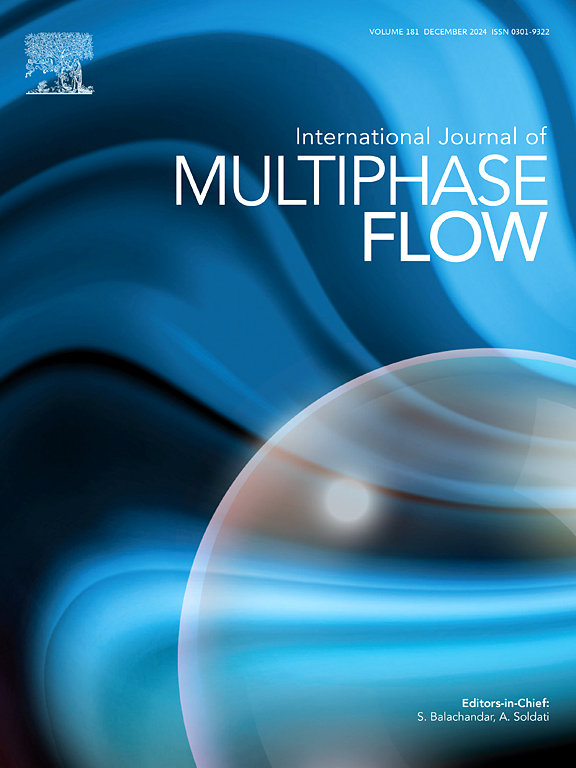Characterization of the critical lift-off of a single flat-plate microchip particle in straight rectangular microchannel flows
IF 3.8
2区 工程技术
Q1 MECHANICS
International Journal of Multiphase Flow
Pub Date : 2025-07-25
DOI:10.1016/j.ijmultiphaseflow.2025.105355
引用次数: 0
Abstract
Hydrodynamic sorting of microchip particles in microchannels is essential in microfluidic systems used for applications requiring particle-based multiplexing. Understanding the forces acting on the particle, as well as the dependencies of the forces on channel and fluid flow parameters, allows for prediction of the flow conditions needed to initiate particle movement, or lift-off. This study presents the experimental characterization of the lift-off of a single, flat-plate, non-neutrally buoyant microchip particle initially sedimented near the inlet of straight, rectangular microfluidic channels of different channel sizes and solvents at moderate Archimedes number of 191 to 2820. The critical shear Reynolds number, corresponding to the minimum required for lift-off, was found to increase with larger Archimedes number and the relationship was found to exhibit particle-channel size dependency. The observed critical lift-off for the flat-plate particle was lower than that predicted using a previous generalized lift-off model based on modified particle Reynolds and Archimedes numbers which may be explained by entrance effects and fluid film lubrication pressure under the particle. Numerical evaluations of the hydrodynamic forces acting on the particle revealed that electrostatic forces are significant. A remodified Archimedes number, based on the channel width, particle diameter, and solvent relative permittivity, is introduced as a correction to the generalized lift-off model to account for hydrodynamics and electrostatics affecting the lift-off of a flat-plate particle. This model is in good agreement with the generalized particle lift-off model and allows for prediction of flat-plate particle lift-off in microfluidic channels for a moderate range of Archimedes numbers.

在直矩形微通道流动中单个平板微芯片微粒临界升力的表征
微通道中微芯片颗粒的流体动力学分选在需要基于颗粒的多路复用应用的微流体系统中是必不可少的。了解作用在颗粒上的力,以及这些力对通道和流体流动参数的依赖关系,可以预测启动颗粒运动或起升所需的流动条件。本研究描述了一个单一的、平板的、非中性浮力的微芯片颗粒最初沉积在不同通道尺寸和溶剂的直矩形微流控通道入口附近,阿基米德数为191 ~ 2820。临界剪切雷诺数(即起升所需的最小值)随阿基米德数的增大而增大,且与颗粒通道大小相关。观测到的平板颗粒的临界升力低于先前基于修正粒子雷诺数和阿基米德数的广义升力模型的预测值,这可能与颗粒下的入口效应和流体膜润滑压力有关。作用在颗粒上的水动力的数值计算表明,静电力是显著的。基于通道宽度、颗粒直径和溶剂相对介电常数的修正阿基米德数被引入,作为对广义升力模型的修正,以解释影响平板颗粒升力的流体力学和静电。该模型与广义颗粒上升模型很好地一致,并允许在阿基米德数的中等范围内预测微流控通道中的平板颗粒上升。
本文章由计算机程序翻译,如有差异,请以英文原文为准。
求助全文
约1分钟内获得全文
求助全文
来源期刊
CiteScore
7.30
自引率
10.50%
发文量
244
审稿时长
4 months
期刊介绍:
The International Journal of Multiphase Flow publishes analytical, numerical and experimental articles of lasting interest. The scope of the journal includes all aspects of mass, momentum and energy exchange phenomena among different phases such as occur in disperse flows, gas–liquid and liquid–liquid flows, flows in porous media, boiling, granular flows and others.
The journal publishes full papers, brief communications and conference announcements.

 求助内容:
求助内容: 应助结果提醒方式:
应助结果提醒方式:


